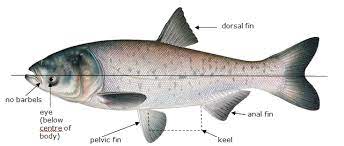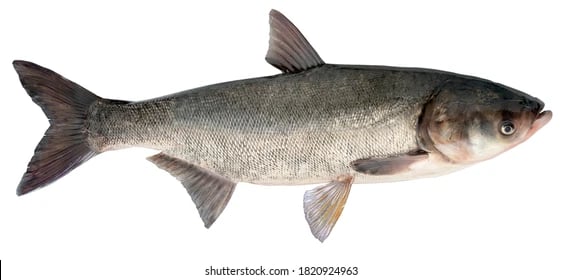Silver Carp Fish Farming
Silver carp is one of the most important fish raised in natural man-made earthen fish ponds in intensive or semi-intensive fish farms in polyculture. Silver carp mainly depends on natural foods, but when it is farmed on a commercial basis then artificial foods besides natural foods are necessary.
FISH FARMING
Silver Carp Fish Farming
Silver carp is one of the fastest-growing fishes in the sub-continent. It is largely cultivated in China, Vietnam, Sri Lanka, and Myanmar. It is a freshwater cyprinoid fish species native to China as well as eastern Siberia. its body is laterally compressed and deep. Ventral keel extending from isthmus to anus. Large head. The eye is small, on the ventral side of the head. Gill rakers are sponge-like. Dorsal fin with 8 rays; no adipose fin. Anal fin with 13 to 15 rays. Lateral line with 83 to 125 scales.
Silver carp is one of the most important fish raised in natural man-made earthen fish ponds in polyculture intensive or semi-intensive fish farms. Silver carp mainly depends on natural foods, but when it is farmed on a commercial basis then artificial foods besides natural foods are necessary, though most of the farmers try to create natural food in the pond using artificial goods or materials.
It can jump up to 10 ft into the air, people call it Flying Carp as its propensity to leap from the water when startled. But is threatened species in its native habitat. According to FAO, silver carp fish live in a temperature range between 6°C to 28°C. They require static freshwater in the earthen natural pond but to produce commercially they require static or slow-flowing freshwater to raise them properly and fast, although they can survive in the various climates of South Asian countries like India, Bangladesh, Pakistan, and Sri Lanka.
Silver carp fish farming commercially is generally done intensively or poly-culture with other native carp fish species, or sometimes with Rohu, Catla, Mrigal, or other freshwater fish species as they are different part food eaters of a pond. Today, the availability of silver carp fish is not difficult in most countries around the world.
Advantages
First, the silver carp fish is grass-eating and low in the food chain. Its feeds and fertilizers are easily available at a very low cost.
Second, the seeds are readily available from artificial breeding without reliance on natural resources.
Third, production management is simpler and the farming period is shorter than for other carp fish species.
Forth, the silver carp fish can be poly-cultured with some other carp fish species, mainly due to its specific habitat.
Fifth, the fish grows faster and reach marketing weight earlier than most other fish species.
Starting the silver carp fish farming business is not so difficult at all. They grow faster than many other carp fish species. However, here is the information about starting and operating a commercial silver carp fish farming business.
Site Selection
First of all, select a very good site for starting a silver carp fish farming business. Consider the following instruction:
First, the selected site has to be free from all types of noise and pollution which will hamper the natural growth of fish in the pond or farm.
Second, it will be very good if the selected site is far from residential areas because land prices are much higher in residential areas and also away from flooded land.
Third, start a silver carp fish farming business if the pond already exists.
Finally, consider the availability of full sun while selecting the site, because sunlight will help to create natural food for fish properly.
Pond Construction
After selecting the site successfully, build or construct a pond properly. Earthen or natural ponds are considered better for starting a silver carp fish farming business. Though concrete, plastic tanks, or other types of artificial ponds are used for fish farming these types of ponds are not good for raising these fish. Hence, it is recommended that construct an earthen pond. It will be better for the silver carp fish farming business if the pond is at least one acre in size, although you can raise the fish in your existing ponds.
Pond Preparation
Prepare the pond for the silver carp fish farming business before filling it with water and stocking fish. Dry up the pond with sunlight properly by using lime. Apply both organic and inorganic fertilizers into the pond for stimulating natural food production and green pond to create natural food for the new fish. The application of doses of lime, organic, and inorganic fertilizers must be used on basis of the farming intensity and inherent productivity of the pond.
Seed Collection
Better seeds are the precondition of better output, which is true in every case of production and for the silver carp fish farming business. The silver carp fish seeds are promptly available in Asian countries from contrived breeding, without trust in instinctive resources. There are many hatcheries available where you can get/collect silver carp fingerlings.
Breeding
In the biological range of Silver Carp fish, it transmigrates upriver for breeding. They drift the eggs and larvae downriver and the young fish crosshatch in the flood-plain partition. Animate beings and small juveniles are fed on zooplankton mainly and they change over to phytoplankton once a sealed size is reached. Normally silver Carp fish can endure salinities up to 12 ppt and low disbanded oxygen which is 3mg per litter, though they tend to be averagely sensitive to low oxygen atmospheric conditions. Broadly speaking, they attain maturity between 4-8 years of age according to FAO but are marked in someplace to be mature as early as in just 2 years. Its eggs require current to stay debarred, with a level best length of spawning river estimated at 100 km and a current speed of 70 cm/s, although they can breed unnaturally. Large money-making hatcheries normally spawn artificially.
Fingerlings
To produce or maintain the fish farm commercially the culture of fingerlings needs special care because the fingerlings are small and soft. As their feeding ability is not strong and they do not adjust well to changes in the external environment, it is needed to maintain their favourable environment. All kinds of predators must be removed as they are not experts enough in averting predators. Hence, well-controlled intensifier systems are required for maximizing survival rate and for raising level-headed fingerlings. Bring up the fingerlings in the nursery pond for up to 30 days. And finally, stock into the main pond carefully when they reach about 8 to 12 cm in body length.
Stocking
Stock the fingerlings into the main pond for silver carp fish farming when they attain between 8 and 12 cm in body length. Silver carp fish is mainly stocked with other carp fish species in the same pond to utilize food given to them to take. And a total stocking density along with other fish species can be 2,000 to 3,000 fish per acre in general.
Feeding
The silver carp fish are phytoplankton feeders or filter feeders, consuming diatoms, din flagellates, golden-brown algae, green algae, yellow-green algae, and blue-green algae, and it possesses a specialized feeding apparatus capable of filtering small particles. Besides, detritus, rotifers, conglomerations of bacteria, and small crustaceans are major components of their natural diet. The Silver Carp fish have no stomachs like the Hypophthalmichthys species. They mainly feed on phytoplankton, but also eat up zooplankton and detritus as well. Because of their plankton-eating habitat, they are somewhere used for ascertaining water quality. There is no need to commercially provide formulated feed in the silver carp fish farming business. Although supplemental fish feeds can be provided if faster growth of the fish is required.
Harvesting
The silver carp is one of the fastest-growing fish species and they reach harvesting size pretty earlier if other things remain constant. Good growth and harvestable size are expected within one year even before that time. But, you can start harvesting when the fish reaches your desired size and market demand. Harvest the fish from the pond by using fishing nets and removing water. But as a rational producer or businessman, harvest the fish based on the size and also depending on the market demand and price.
Marketing
The main purpose of the silver carp fish farming business is to make a profit which will come true by marketing successfully and with some strategy. People always like to buy fresh and live fish. Hence, go to the market with live and fresh fish. It is essential to keep them alive from harvesting to marketing. Trucks, boats, or other transporting vehicles containing water are used for transportation in most areas. Try marketing as early as possible after harvesting.
Conclusion
Silver Carp fish farming is very important for rural aquaculture development and employment creation. They are very popular in some countries as food. They can live up to 20 years. Spawning occurs at temperatures greater than 18 °C; on average, a female can lay up to 5 million eggs annually.




